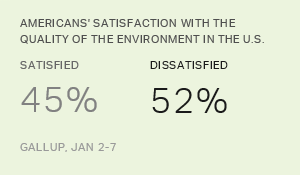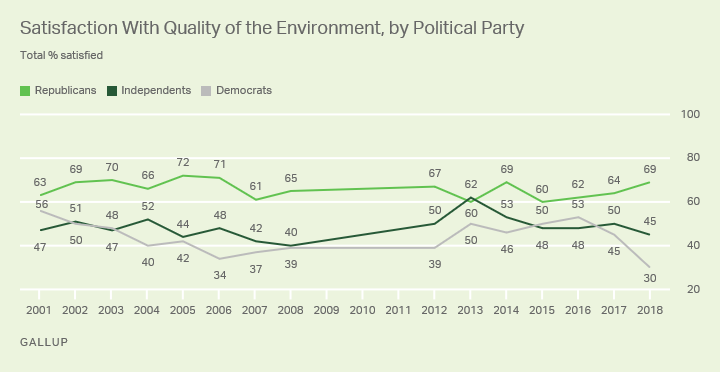
Satisfaction With Quality of Environment in U.S. at New Low
by Justin McCarthy
Story Highlights
- More Americans dissatisfied (52%) than satisfied (45%)
- First time majority dissatisfied in Gallup's 18-year trend
- Democrats' satisfaction with environment quality at record low
WASHINGTON, D.C. -- Americans are slightly more likely to be dissatisfied
(52%) than satisfied (45%) with the quality of the environment in the
U.S. This is, by one percentage point, the lowest level of satisfaction
with environmental quality in Gallup's 18-year trend, and the first
time the percentage of dissatisfied Americans has exceeded 50%.
These data are from Gallup's annual Mood of the Nation poll, conducted
Jan. 2-7, 2018. This is the first measure of Americans' views on this
question during Donald Trump's presidency.
Changes to environmental regulations have been among the Trump administration's
most sweeping policy reversals, fulfilling Trump's campaign pledges
to roll back Obama-era regulations deemed burdensome to economic growth.
The policy reversals include withdrawal from the Paris Climate agreement,
eliminating certain emissions standards and repealing bans and standards
on oil and gas drilling.
For most of Gallup's trend going back to 2001, a slight majority of
Americans have said they are satisfied with the nation's environmental
quality. Satisfaction has now reverted to roughly its previous low of
46% in 2007, when concerns about global warming spiked. This could have been partly
related to the previous year's release of former Vice President Al
Gore's documentary, "An Inconvenient Truth," which sought
to bring light to the issue of climate change, as well as President George
W. Bush's waning popularity.
Democrats' Satisfaction With Quality of Environment Plummets by 15 Points
Democrats have generally been the least satisfied party group when it comes
to environmental quality, as their party has long assumed the mantle of
protecting against climate change and the environmental impact of energy
production. But Democrats' satisfaction is now at its lowest level
since 2001 after falling sharply in the past year, from 45% to 30%, with
the transition from Barack Obama's to Trump's administration.
It is down a total of 23 points from before the 2016 election.
In sharp contrast, at least six in 10 Republicans have been satisfied with
the quality of the environment over the past 18 years.
Just under half of independents, 45%, are satisfied with the current state
of U.S. environmental quality. Independents' views have generally
been closer to those of Democrats on this measure, but with this year's
large drop in Democratic satisfaction, the difference between independents
and Democrats is the largest to date.
Bottom Line
Many of the Trump administration's changes to environmental regulations
have not yet taken effect or have not been enacted long enough to have
a noticeable impact on the environment. It's likely, then, that the
dip in Americans' satisfaction with the environment is a reaction
among Democrats to the about-face on many key governmental policies rather
than any real changes being experienced. Americans' ratings of Trump's
handling of the environment are
among his lowest marks on a list of issues -- and significantly lower than the ratings Obama
and Bush received on the environment.
However, 2017 was one of the hottest years on record, and Americans may
be answering with those recent high temperatures in the back of their
minds -- not to mention a particularly devastating hurricane season that
upended many Americans' homes and lives.
Trump has conceded little, if anything, to the environmental concerns raised
by scientists and environmental activists. He tends to play to his Republican
base, which expresses less concern than other party groups about
global warming. So his presence in the White House will likely leave Democrats dissatisfied
with environmental policy as long as he is president.
But it's possible that if 2018 is a tamer year in terms of temperatures
and natural disasters, Americans at large may come to a more positive
view of the environment's quality.
Survey Methods
Results for this Gallup poll are based on telephone interviews conducted
Jan. 2-7, 2018, with a random sample of 1,024 adults, aged 18 and older,
living in all 50 U.S. states and the District of Columbia. For results
based on the total sample of national adults, the margin of sampling error
is ±4 percentage points at the 95% confidence level. All reported
margins of sampling error include computed design effects for weighting.
Each sample of national adults includes a minimum quota of 70% cellphone
respondents and 30% landline respondents, with additional minimum quotas
by time zone within region. Landline and cellular telephone numbers are
selected using random-digit-dial methods.
Learn more about how the
Gallup Poll Social Series works.




